In the Qur’an, Allah calls us to give attention to birds with His verse "Have they not looked at the birds above them, with wings outspread and folded back? Nothing holds them up but the All-Merciful. He sees all things."
(Surat al-Mulk: 19) In this part, we will particularly review migratory birds; we will describe what perfect balances they establish travelling in the skies, and the systems their bodies are endowed with, and focus on the wonder of Allah’s upholding them "in the sky".
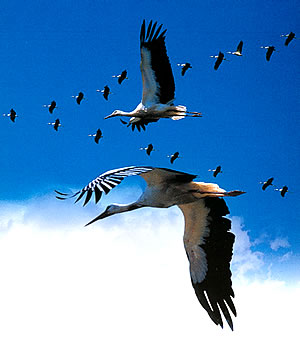 |
Why and how birds started to migrate and what made them take the "decision of migration" have long been topics of interest. Some scientists hold the reason of migration to be seasonal changes while some others believe the reason to be the search for food. What deserves consideration is how these animals, having no protection, technical outfit, and security but only their bodies, can make these very long-distance flights. Migration requires some special skills like orientation, food storage, and the ability to fly for long periods. It is impossible for an animal not possessing these characteristics to transform into a migratory animal.
One of the experiments made to address this issue is as follows: garden nightingales were subjected to experiments in a lab where internal conditions such as temperature and light could be varied. Internal conditions were arranged differently from external conditions. For instance, if it was winter outside, a spring climate was created in the laboratory and the birds arranged their bodies in accordance with that. The birds stored fat for fuel, just as they do when time for migration approaches. Although birds organised themselves according to the artificial season, and prepared themselves as if they were going to migrate, they did not set out to migrate before it was time. They observed the season outside. This was evidence that birds do not take the decision to start migration according to seasonal conditions.
How, then, do birds determine the time for migration? Scientists have still not found an answer to this question. They believe that living things have "body clocks" that help them to know the time in a closed environment and to differentiate seasonal changes. However, the answer that "birds have body clocks with which they understand the time of migration" is an unscientific answer. What kind of clock is it, which organ of the body does it work with, and how did it come into being? What would happen if this clock were out of order or stayed behind?
Considering that the same system holds true not only for a single migratory bird, but for all migratory animals, more importance must be attributed to these questions.
As is well known, migratory birds do not start migration from the same place, as none of them are found at the same place when the time for migration arrives. Most species first meet at a particular location and then migrate together. How do they arrange such timing? How are these "body-clocks", that birds allegedly have, so harmonious? Is it possible that such a systematic order could come into being spontaneously?
It is impossible for a planned action to take place spontaneously. In addition, neither in birds nor in other migratory animals is there a clock of any kind. All migratory living things do this every year at times determined by them, but they do not do it by observing a body clock. What some people call a body clock is Allah’s control over these living beings. Migratory animals follow Allah’s orders just like everything in the universe.
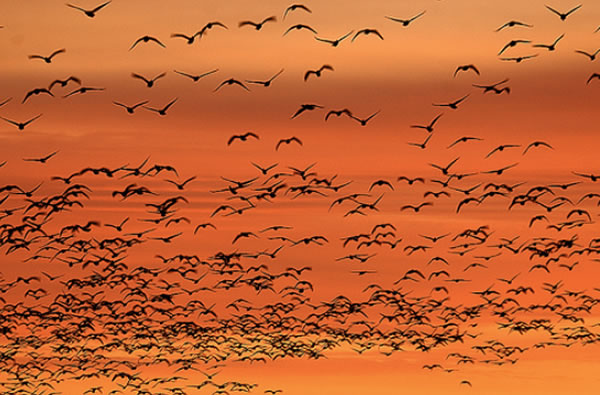 |
| "Do you not see that everyone in the heavens and earth glorifies Allah, as do the birds with their outspread wings? Each one knows its prayer and glorification. |
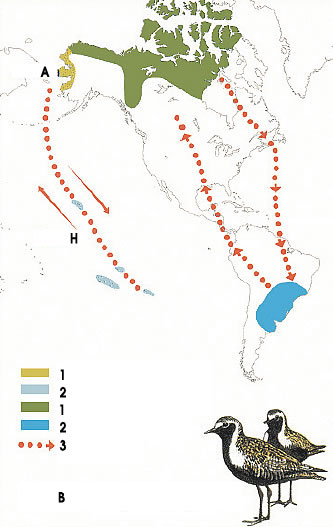 |
Birds consume great energy in flight. For this reason, they need more fuel than all sea-dwelling and land-dwelling animals. For instance, in order to fly the 3,000 km distance between Hawaii and Alaska, a humming bird, weighing a few grams, has to beat its wings 2.5 million times. Despite this, it can remain in the air for as long as 36 hours. Its average speed during this trip is approximately 80 km per hour. During a flight as arduous as that, the quantity of acid in the bird’s blood increases excessively and the bird faces the danger of fainting because of its rising body temperature. Some birds deal with this danger by landing. How, then, can those that migrate over enormous oceans save themselves? Ornithologists have observed that under such circumstances, birds spread their wings as wide as possible and so cool down by resting in this manner.
The metabolisms of migratory birds are strong enough to put up with this task. For instance, the metabolic activity in the body of a humming bird, the smallest bird of passage, is 20 times more than that in an elephant. The body temperature of the bird rises to 62o C.
In addition to having been created ready to endure such arduous flights, birds are also gifted with skills that enable to them to make use of favourable winds.
For instance, storks go up as high as 2,000 m with rising warm air currents, and then glide along swiftly to the next warm air current without beating their wings.
Another flight technique used by bird flocks is the "V" type flight formation. In this technique, big strong birds at the front function as shields against counter air currents and lead the way for the weaker. Aeronautical engineer Dietrich Hummel has proved that with such organisation, a saving of 23% is achieved in the flock in general.
Some migrating birds fly at very high altitudes. For instance geese can fly at an altitude of 8,000 m. This is an incredible altitude considering the fact that even at 5,000 metres the atmosphere is 63% less dense than at sea level. Flying at such a height where the atmosphere is so thin, the bird has to beat its wings faster and hence has to find more oxygen.
However, the lungs of these animals are created in such a way as to take maximum benefit from the oxygen available at these heights. Their lungs, which function differently from those of mammals, help them obtain higher level of energy from scarce air.
 |
| When the bird ascending in the warm air current reaches the top, it glides down swiftly. This helps the bird save a great amount of energy both in ascent and descent. |
During migration, birds also take atmospheric phenomena into consideration. For instance, they change direction to avoid a coming storm. Melvin L. Kreithen, an ornithologist who made research into birds’ sense of hearing, observed that some birds can hear sounds of extremely small frequencies, which diffuse to great distances in the atmosphere. A migratory bird can therefore hear a storm breaking out over a far away mountain or thunder over an ocean hundreds of kilometres ahead. Besides, it is a known fact that birds are careful to set their routes of migration away from regions where atmospheric conditions are risky.
How do birds find their direction without the help of a map, a compass or some similar direction finder during their thousands of kilometres long flights?
The first theory put forward regarding this question was that birds memorise the characteristics of the ground beneath them and thus reach their destination without being confused. Yet, experiments have shown that this theory is incorrect.
In an experiment on pigeons addressing this subject, opaque lenses were used to blur the vision of pigeons. Thus, they were prevented from navigating by landmarks on the ground, yet the pigeons could still find their way even if left some kilometres away from their flocks.
 |
| Only five centimetres tall. |
Subsequent research has shown that the magnetic field of the earth seems to act on bird species. Various studies have shown that birds have seemingly advanced, magnetic receptor systems enabling them to find their way by making use of the magnetic field of the earth. This system helps birds determine their direction by sensing the change in the magnetic field of the earth during their migrations. Experiments reveal that migratory birds can even perceive a 2% variation in the magnetic field of the earth.
Some think that they can explain the subject away by saying that birds have a sort of compass in their bodies. The main question, however, lies just here.
The question is: how do the birds come to be equipped with a "natural compass"? We are aware that the compass is an "invention" and a work of human intelligence. So how does a compass - an apparatus produced by man with his collected knowledge - come to exist in the bodies of birds? Is it likely that some years ago, a bird species, while finding direction, thought about making use of the magnetic field of the earth and invented a magnetic receptor for its own body? Alternatively, was a bird species, years ago, equipped with such a mechanism by "coincidence"? Definitely not....
Neither the bird itself nor a coincidence can add an extremely advanced compass to the body. The bird’s body structure, lungs, wings, digestive system and its ability to find direction are the examples of the perfect creation of Allah:
"He is Allah - the Creator, the Maker, the Giver of Form. To Him belong the Most Beautiful Names. Everything in the heavens and earth glorifies Him. He is the Almighty, the All-Wise."(Surat al-Hashr: 24)
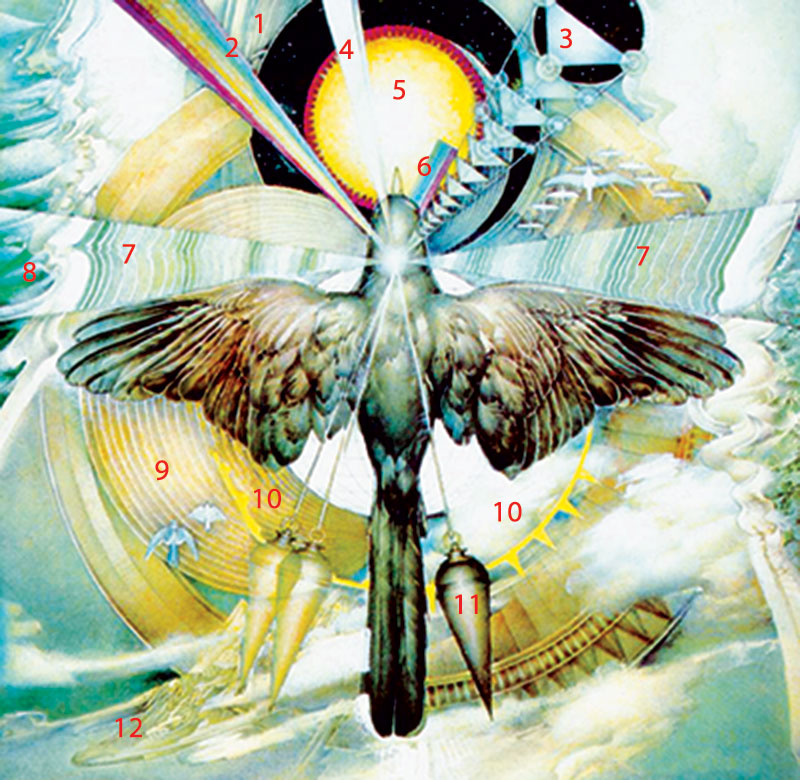 | |
| The above illustration shows the twelve factors beneficial to birds while flying: | |
| 1. The sun, | 7. Sounds such as of waves and thunder coming from very far away, |
The migration story of Monarch butterflies, which live in southeast Canada, is more complex than that of the birds.
Monarch butterflies normally live for only 5-6 weeks after they develop from caterpillar. Four generations of Monarch butterflies live within a year. Three of these four generations live in spring and summertime.
With the coming of autumn, the situation changes. Migration starts in autumn and the generation that migrates, lives much longer than the other generations that lived in the same year. The Monarchs that migrate are the fourth generation in the year.
Interestingly enough, the migration starts exactly on the night of the autumn equinox. The butterflies that migrate to the south live six months longer than the previous three generations. They need to live exactly this long to complete their journey and return.
The butterflies that go down to the south do not disperse after they pass across the Tropic of Cancer and leave the cold weather behind. After migrating over half of the American continent, millions of butterflies settle down in the middle of Mexico. Here the ridges of volcanic mountains are covered with a great variety of flora. Located at a height of 3,000 metres, this place is warm enough for the subsistence of the butterflies. For a period of four months, from December to March, they eat nothing. As the fat stored in their bodies nourishes them, they only drink water.
Flowers that bloom in the spring are quite important for the Monarchs. After a four-month fast, for the first time, in the spring they give themselves a nectar feast. They now have stored enough energy to return to North America. This generation, which lives a two-month life span extended to eight months, is no different from the three earlier generations in other respects. They mate at the end of March before setting out to their journey. On the equinox, the colony starts flying back to the north. Soon after they complete their journey and arrive in Canada, they die. However, before they die, they give birth to a new generation, which is necessary for the perpetuation of their species.
The newly born generation is the first generation of the year and lives about one and a half months long. Then comes the second and third generations. When it comes to the fourth generation, migration starts over again. This generation will live six months longer than the others will, and the chain will continue in the same way.
This interesting system provokes many questions: how is that the fourth of every four generations lives six months longer? How does this long-lived generation always coincide with winter and has done so for thousands of years? How do these butterflies always start migrating at the equinox, and how do they attune themselves so sensitively, or are they using a calendar?
No doubt, there are no answers to these questions through "evolution" or other variants on that theory. The butterflies must have borne these interesting characteristics from the time they came into existence. If the first fourth generation of Monarchs on earth did not have the characteristic to live long, then all the butterflies would die within that winter and these animals would become extinct.
Monarchs must have borne this extraordinary characteristic from the time they were created. "Coincidences" unquestionably do not have such a faculty as could arrange the generations of the animal according to migration. On the other hand, it is also unlikely that butterflies decided to make their fourth generations live longer and arranged their metabolisms, DNA and genes accordingly.
Obviously, the Monarchs were created possessing such features.
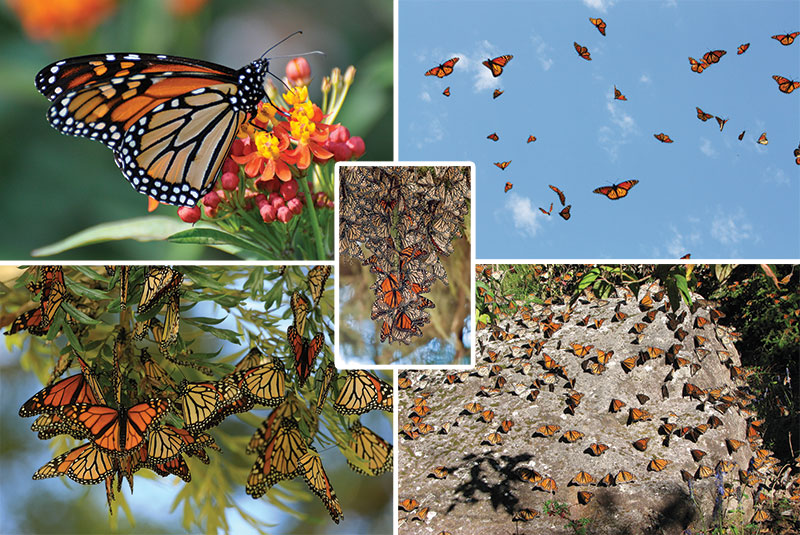 |
| When thousands of Monarchs perch on a tree, the tree becomes invisible. |